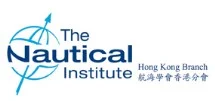summary
archive > archive documents > conference 2022
Hong Kong SAR 50th anniversary event
The changing face of seafaring
The changing face of seafaring
The Hong Kong branch of The Nautical Institute centred the programme of their 50th anniversary event around what Aalok Sharma described in his opening speech as ‘The most important asset of the maritime community— the men and the women at sea’. Held in the suitably maritime surroundings of the Royal Hong Kong Yacht Club, with a view out to the busy harbour traffic, this was a fantastic setting for a day of discussions around the future of the industry.

Very much in tune with the theme of the day, Chief Guest Carol Yue, Director of Marine for the Hong Kong SAR, said that in recent years, the industn has been facing rnajor disruption and ‘unprecedented and tremendous change’. In such a time, she said, 'We are grateful for nautical practitioners who coped quickly, professionally and proactiively .’ For the future, ‘people are the key. We need talented maritime practitioners and highly educated seafarers.’ With this in mind, Hong Kong’s marine department willl continue to work closely with marine professionals to develop marine leadership.
Before looking to see what the future holds, we first took a step back, with Alan Loynd presenting a brisk walk down memoir lane, looking back at the history of the branch, and the astonishing development of Hong Kong as a port and as a ship registry over the years— to say nothing of the equipment on board ship. ‘We were told in an early meeting of the Branch that although some people regarded microcomputers on Board as inevitab1e, mariners would give them short shrift. At
the time, I would probably lave agreed,’ he recalled. But even with the rapid, and rapidly accelerating, pace of technological change, some things still sound familiar. ‘In 1985, we were told integrated, highly technical bridge systems were about to descend on us, and wouldn't standardisation be useful?' It took 30 years before that could be achieved.
Panel: the modern face of seafaring
A substantial panel session followed the coffee break, set up according to a pattern which moderator Aalok Sharma said was 'like a chatshow - we get celebrities and put them on the spot' - in this case, to discuss the modern face of seafaring. The celebrities represented different faces of the maritime industry;
most of them having been at sea themselves before taking up their current career. Under Aalok's questioning, the panel explored what changes need to take place on board, and what facilities, to attract today's seafarer, as the perspective on work is changing and the focus increasingly moving from 'making ends meet' to 'improved standards of living on board'.
'In the years since I started at sea, possibly some of the biggest changes we have seen have been in the last couple of years,' said Sanjeev Verma of Landbridge Hong Kong.
In order to keep up with the changes of the future, shipowners are going to have to start making changes now. 'The mindset of
shipowners that you treat the ship as an asset has to be changed - the asset is managed by people, and we have to remember that.
Once ships are built, a lot depends on how it is managed, but hardware and software is hard to change once a ship is up and running. Instead, you have to think upfront about how you use technology to make decisions easy.' If conditions at sea are such that we can't tell our own kids to go to sea, we are doing something wrong, he concluded.
In fact, we can already do just that, said Bjorn Hojgaard, CEO Anglo Eastern Ship Management. 'If l look at the changes that are happening, I think there is no better time to become a seafarer. The rapid change in technology ' and the new challenges involved propulsion and energy modal shift are going to make seafarer life enormously challenging and also enormously exciting.' he said. 'One of the best hidden secrets is communications revollution that is happening right under our nose. Low earth satellite systems are going to mean every ship is going to be connected the same way as every office. That’s going to change everything — the ship will no longer be this isolated unit that is not really plugged in.

Technology can be seen as much as a danger as an opportunity, though. ‘One of the biggest changes I see in discussions with - seafarers is that they are concerned technology will takte jobs. said Gautam Lahiry of ABS. Any changes will be gradual, though, not least because of the legal safeguards in place. At present, all the pillars of maritime authorihy assume there will be a Master and certified officer on board the ship. It is going to be a paradigm shift.
My assurance is that automation is something that is not going to cost seafarers their jobs; it is going to complement the seafarers.’ We need a mindset of ‘digital ergonomics’, creating a hybrid on a board ship, where technology supports the seafarer, he said.
Andre Kroneberg, representing Gard Asia, emphasised that it is very difficult for companies to look even as little as two or three years ahead. Given the massive uncertainty it's important for all companies to consider alternative scenarios and discuss how we would cope with a range of possible futures. Points to consider include compliance with a number of complex sanctions regimes and potential consolidation. In terms of
decarbaonisation, ‘we are moving from polluting fuels to toxic fuels’ — this may create interesting new risks.
More positively, focus on data collection and smarter use of data will lead to more data- driven loss prevention initiatiives. Increasingly, we can spot trends at an earlier stage, share knowledge, and try to avoid incidents and accidents proactively — for example, identifying hotspots where there is a high risk of cargo liquefaction and warning members in advance.
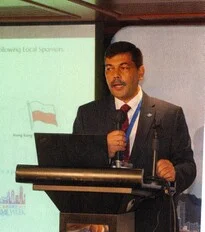
In a lively question and answer session, one member pointed out that the expectations placed on seafarers have gone up. ‘Any new equipment means more work, not just learning to use it but to maintain it. Are we giving seafarers enough time to en joy all these other benefits on board? I cannot see any change in the minimum safe manning requirements, despite all these changes.’ Sanjeev Verma agreed that ‘Seafarers are bombarded with changes from shoreside, but it can't be just the seafarers who take responsibility. We need to start simplifying things before we send them on to the seafarers. The solution is for companies to look into their own procedures.’
Another audience member asked whether we are paying enough to attract junior officers. This is not a problem, said Bjorn Hojgaard: ‘I have 22,000 applications for 480 cadet places, there's no shortage.’ This makes it all the more important for seafarers to focus on their own professional development and find ways to make themselves stand out.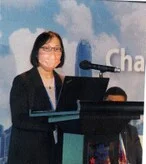

A wide-ranging discussion went on to look at issues of welfare and wellbeing. One question raised the topic of bullying and harassment on board, and how these can be prevented. A difficult question, and one which initially was met with silence. One member of the panel hopes this will be alleviated with better connectivity leading to closer integration with the shore and shoreside norms. Out of sight will no longer mean out of mind.
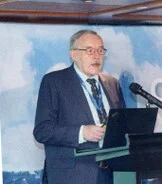 Another tricky question is that of the fair treatment of seafarers internationally,
Another tricky question is that of the fair treatment of seafarers internationally,including those caught up in cases such as the recent detention of the Heroic idun. ‘These cases make seafaring really unattractive. What can we do to support seafarers and reassure people that they won't be treated like this?’ Another important question: and one which needs international cooperation.
Two more positive comments closed the session, with Petty Leung saying: ‘I have got so much out of this industry — I would reassure cadets they have the possibility of brilliant career ahead.’ She asked whether a more structured path to link seafarers’ path at sea to future paths ashore would be a helpful way of increasing participation in the industry.
Bjorn Hojgaard summed up, saying: ‘We tend to talk about the problems when we get together, but this can be an amazing path to a very rewarding life. The many changes we are seeing are going to bring so many opportunities.’
Technology and navigation
Richard Oakley, a partner at Ince & Co gave a detailed presentation on passage planning and the legal implications of ECDIS, as seen in the case of the CMA CCM Libra, which hit uncharted rocks leaving the channel.
This fed into a wider discussion of how ships come to go aground, often as a result of commercial pressure to (literally) cut corners. With all the information now available, and the multitude of tasks that the Master has to perform, including working cargo,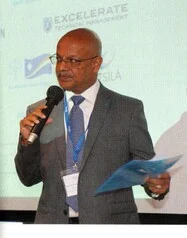 are we now at a point where passage planning needs to be done ashore, Oakley asked. He was keen to emphasjse that he was in no way suggesting removing the Master's decision making power, simply that plans could be prepared ashore, then beamed on board and talked through, with the final say still coming down to the Master. ‘That ultimately is how the aviation industry does it. I don't like taking the power away from Masters, they still have to have the final say, but there is so much corner cutting going on — and this would at least alleviate commercial pressure.’
are we now at a point where passage planning needs to be done ashore, Oakley asked. He was keen to emphasjse that he was in no way suggesting removing the Master's decision making power, simply that plans could be prepared ashore, then beamed on board and talked through, with the final say still coming down to the Master. ‘That ultimately is how the aviation industry does it. I don't like taking the power away from Masters, they still have to have the final say, but there is so much corner cutting going on — and this would at least alleviate commercial pressure.’
 are we now at a point where passage planning needs to be done ashore, Oakley asked. He was keen to emphasjse that he was in no way suggesting removing the Master's decision making power, simply that plans could be prepared ashore, then beamed on board and talked through, with the final say still coming down to the Master. ‘That ultimately is how the aviation industry does it. I don't like taking the power away from Masters, they still have to have the final say, but there is so much corner cutting going on — and this would at least alleviate commercial pressure.’
are we now at a point where passage planning needs to be done ashore, Oakley asked. He was keen to emphasjse that he was in no way suggesting removing the Master's decision making power, simply that plans could be prepared ashore, then beamed on board and talked through, with the final say still coming down to the Master. ‘That ultimately is how the aviation industry does it. I don't like taking the power away from Masters, they still have to have the final say, but there is so much corner cutting going on — and this would at least alleviate commercial pressure.’ Benjamin Wong, head of maritime cluster at Invest Hong Kong, highlighted the disparity between the public impression of shipping, which can be of a rather old-fashioned industry, and the amount of investment and development that is being put into it. Making people aware of this is an important aspect in appealing to the younger generation, he said'not just at university, but right from the start'.
Later in the day, Capt Yudi Sudirman, General Manager Marine and EST, Mitsui OSK, outlined some of the forms this investment was taking, including the development of the Environment Wind Challenger, an MOL vessel which employs hard sails to assist the ship's propulsion.
This is jusf one step on the path to net zero emissions. However, shipping has a key part to play in decarbonisation, not just by cutting its own emissions, but by providing the fuels and materials that will permit full-scale decarbonisation ashore.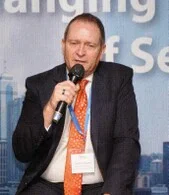

Green transition
The after lunch sessions took a closer look at the details of this investment, in particular in terms of green technology. Insurers may not seem to be at the forefront of the development of new technology, but in fact they have an important role to play, said Andre Kroneberg. ‘We have to be ready to take on new risks, new disputes, and new claims arising out of new technology,’ he said. ‘We have to be ready to take on new risk even if we may not be able to fully rate it in the first few years.’ The transition period from existing to future fuels may see claims relating to the long-term effects of slow steaming, including potential strain on engines, or even cargo damage claims. ‘There are lots of opportunities for new types of risk arising from these measures but that doesn't mean that we shouldn't take them,’ he concluded — instead, we should take them and insure against them.
Digital transformation
Capt Ashok Sharma from Wartsila Voyage looked at how digital transformation can be used to unlock shipping's potential. ‘Like it or not, digitalisation has been affecting us,’ he said. This does not have to be a negative — automation can cut down on human error in making reports, updating charts, allowing more time for other matters.’ Possibilities include:
0 Connected ECDIS — full ship to shore connectivity means that you can see where the ship is from second to second. Information is not only near instant, but available for replay.
0 Performance monitoring and fuel efficiency — there are many areas of a vessel environment that are being monitored, analysed and where a decision can be taken based on quantification. A connected bridge allows for a new way of ship to shore reporting.
0 Better situational awareness and collision avoidance.
Human skills are still required, but teclinology ensures that even one has the same understanding of the situation — for example, the engine room can see what is happening on deck at bow, stern, rnidship during a berthing manoeuvre, and will have better understanding of what the bridge staff are asking for and why. Far from adapting to or resisting the power of digitalisation, there is a third option — to harness it.

New training for new challenges
George Cheng, business director, OTG picked up on a theme which has recurred throughout all the 50th anniversary events — as technology is advancing, so the required seamanship skills are changing. For all the new tech on board, having the right crew is definitely the key to success going forward. It is people who deliver the required outcome. Having the right people will be the differentiator; recruitment and retention of qualified candidates will be more important than ever.
Unfortunately, training requirements are currently behind the actual need. While the current model is fine for basics, with all the extra systems on board, the ship is becoming more like a gadget — and the training that wee offer needs to reflect that. STCW was introduced in 78, revised in 2010, but still was behind what is required. It is important for shipping companies to invest in things like certification courses for new technologies — we are looking to invest in things like ‘serious gaming’. One way of doing this is through focusing on competency management and the ability to perform the tasks in practice.
‘Most of the time, our seafarers are not short of ideas; what they lack is time. We need to ride on the new technologies to see how we can help them save time, and allow them to go on learning on the move.’
Seafarer rights
Rosita Lan, a partner at Ince & Co, outlined how the legal complexity surrounding seafarer employment can add further difficult to what are already tragic situations — it can be surprisingly hard even to establish whether a disappeared person is missing or not, or which country is responsible for deciding this. Amid all the discussion of cutting-edge technology, there are still some very basic matters that have yet to be dealt with, and it is nrportant not to lose sight of this.
Developing professionals
NI Chief Executive John Lloyd explained the work that went into developing The Nautical Institute's current strategic plan, and the overall framework within which the NI operates.
‘STCW is only at the beginning of the processional journey, and we really want to support people in their professional development as they move through their careers,’ he said. ‘We need to recognise that if people are going to be successful in developing their careers, they need a whole
range of personal skills and life skills.’ One major way in which the NI is investing in the future is by making a move to bring in younger seafarers at an early age, with the introduction of free student membership - and broadening the reach of the Institute to include the fishing sectors, inland waters, and superyachts.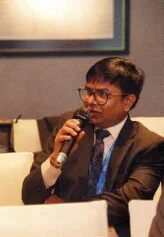

Closing the event, NI President André LeGoubin ended on an optimistic note: ‘We have very’ little idea what future vessels will look like, but hasn't every generation of seafarers been the same? There's no way the master of my first vessel could ever have envisaged the technology I use today, but he passed on skills that are still the basis of what I use today. Just as I did, tomorrow's seafarers will be able to take what we pass on, adapt it, and use it as the basis of their own skills.’ The evening closed with a chance for everyone to continue the discussions over cocktails, thanks to our generous sponsors.
